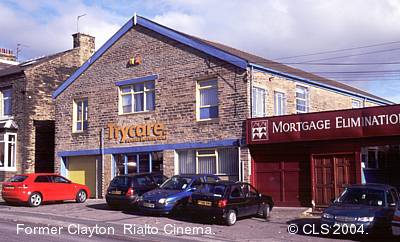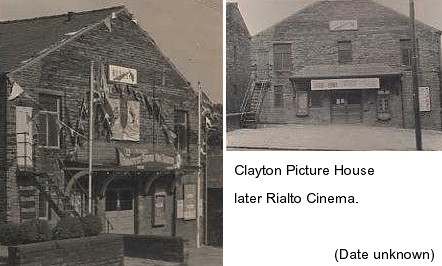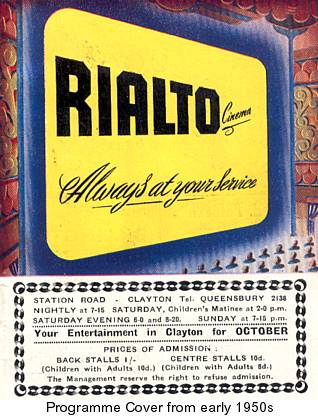|
Clayton/Rialto Cinema Station Road, Clayton, Bradford.

A purpose built stone cinema in the centre of the old part of Clayton village. A single deck hall with 450 seats and a proscenium width of 18 feet. Location The Building Building work commenced in February 1916 in the middle of the First World War when materials and labour were in short supply - a bold move for its owner Albert Harrison. Despite difficulties the hall was said to be "tastefully decorated and equipped". William F.G Phillips of the Imperial Animated Picture Company of Hustlergate in Bradford also had an interest and his company installed Pathé Imperial No 1 projectors and supplied some of the films from his film rental company just as he was doing at his own Regent in Manningham Lane. The Opening(s) "Beaulah" - 1915 USA B/w SilentClayton was then right on the western outskirts of the city and it appears that it did not advertise in the two city newspapers but confined its publicity to handbills around the village. It is not clear, therefore, whether it continued business for the next four years or closed for a period. However, it would appear that by 1920 William F.G Phillips had taken over and presumably made some alterations/refurbishment and re-opened the Clayton Picture House on Monday 22nd November 1920 with the special feature . . . "The Melting Pot" - 1916 USA B/W Silent The advertisements proclaimed "The Best Pictures Only - See them here in comfort". Prices were 5d to 1/-d for the once nightly shows (except Sundays). Phillips now advertised his cinema regularly in the Bradford Daily Telegraph and Bradford Argus. Many Proprietors In 1932 now with Roy Firth as proprietor, its name was changed to Rialto Cinema. Firth's own sound system was installed, but by 1935 Harrison's sound system was fitted. Will Phillips, previously of the Wilsden Picture House, became manager. W.F.G. Phillips had been managing director of the Regent Picture Theatre in Manningham Lane from 1914 to 1925. Later owners included Dean & Heggs and Joe Emmott's Dales Cinemas also controlling the Queen's Hall, Laisterdyke and Thornton Mechanic's Picture House. In later years the Rialto was owned by Alfred A. Howarth once the assistant projectionist when it was the Clayton Picture House, the Savoy in Darley Street and Theatre Royal in Manningham Lane; he was to buy the Rialto in 1952. Around 1940 Stanley Lister Proud was the chief projectionist. Fire Disaster The cinema remained closed for over a month whilst Alfred Howarth took the opportunity to completely refurbish and redecorate the hall and installed a new wide screen. Major Refurbishment The electrical installation and lighting effects of the Rialto were originally installed by Herbert Smith (Bradford) Ltd of Longside Lane, Lidget Green only a couple of months before the fire. Herbert Smith then had to re-service and completely renovate the entire installation again. The projection room was equipped with the latest RCA sound reproducer, "Strong" Electrical Corporation (GB) Ltd high intensity arcs and Westinghouse Brake & Signal Co Ltd "Westalite" rectifiers. Grand Reopening 1. The National AnthemThe film "Metroscopix" required the use of red/green cardboard glasses to be hand-held in front of the eyes. Newspaper announcements said: "So real it comes out of the screen almost to touch you - On the new Wide Screen". Closure "Shadow of a Man" - 1954 UK B/WFollowing the closure of the Rialto, its proprietor Alfred Howarth was later to return to the Theatre Royal where he became a director and secretary of the company before retiring to the Dales. In June 1956 the Rialto was put up for auction by John H. Raby - it was offered as a going concern but the property was withdrawn when bidding reached only £2,000. Later use of Building May not be copied or reproduced without permission.
|
 A purpose-built stone picture hall of plain rectangular design with pitched tiled roof. The single-deck hall with its auditorium running roughly west to east away from Station Road, The central wood canopied front entrance and small lobby led to the auditorium with raked floor and 450 seats. Prescenium opening of 18 feet with a small stage. The projection room above the entrance lobby had a wrought iron emergency staircase down to pavement level.
A purpose-built stone picture hall of plain rectangular design with pitched tiled roof. The single-deck hall with its auditorium running roughly west to east away from Station Road, The central wood canopied front entrance and small lobby led to the auditorium with raked floor and 450 seats. Prescenium opening of 18 feet with a small stage. The projection room above the entrance lobby had a wrought iron emergency staircase down to pavement level. A grand re-opening performance was held on Monday 19th October 1953 at 7.00pm by the Lord Mayor of Bradford, Alderman Angus Crowther, J.P., who also represented Clayton on the city council, accompanied by the Lady Mayoress Miss Annie Crowther.
A grand re-opening performance was held on Monday 19th October 1953 at 7.00pm by the Lord Mayor of Bradford, Alderman Angus Crowther, J.P., who also represented Clayton on the city council, accompanied by the Lady Mayoress Miss Annie Crowther.